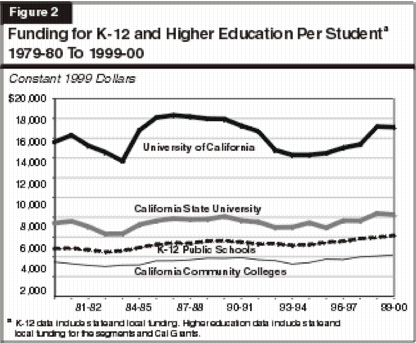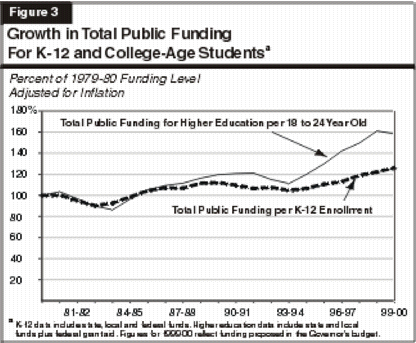Education
![]() Enhancing Teacher Quality
Enhancing Teacher Quality
![]() Accountability
Accountability
![]() Deferred Maintenance
Deferred Maintenance
![]() Budget Detail Lacking for California State University and University of California
Budget Detail Lacking for California State University and University of California
![]() California State University Teacher Preparation Enrollments
California State University Teacher Preparation Enrollments
![]() Additional Cal Grant T Awards
Additional Cal Grant T Awards
Education
The Governor's budget includes a total of $33.1 billion in Proposition 98 funding for K-12 schools for 1999-00. This is an increase
of $1.5 billion, or 4.9 percent, over estimated expenditures in the current year. The budget includes a total of $9.3 billion in
support for higher education, including financial aid for college students.
Figure 1 shows Proposition 98 and General Fund support for K-12 and higher education for three years.
1998-99 The Proposition 98 request for K-12 represents around $5,900 per student, as measured by average daily attendance (ADA). The budget
request for community colleges represents about $3,900 per full-time-equivalent (FTE) student. The proposed General Fund budget for the
California State University (CSU) represents about $7,700 per FTE student, and the proposed General Fund budget for the University of
California (UC) represents about $15,700 per FTE student. To place funding for K-12 and higher education into a historical perspective, we have compared funding per student for K-12 schools and
the three public higher education segments from 1979-80 through 1999-00, adjusting for the effects of inflation over this 20-year period
(see Figure 2). As the figure shows, per student funding for each segment, after adjusting for the effects of inflation, is at or near their highs
over the past 20 years. Figure 3 provides another perspective on inflation-adjusted funding over time for K-12 and higher education. The figure shows the
percentage of 1979 funding that K-12 and higher education have received over time per K-12 enrollment and per 18-to-24-year old. It
indicates that funding effort for the two groups tracked fairly closely through 1993-94. Since that time, however, funding per 18-to-24-year old has outpaced funding per K-12 enrollment. Growth in higher education funding per
18- to-24-year old reflects, in large part, the significant increase in college participation among the college-age population. The figure also
suggests that the level of public subsidy for both K-12 students and college-age adult, after adjusting for inflation, has increased over the
past 20 years. Below we describe how Proposition 98 allocates state funds for K-12 and community college programs. The voters enacted Proposition 98 in 1988 as an amendment to the California Constitution. That act, which was later amended by
Proposition 111, establishes a minimum funding level for K-12 schools and the California Community Colleges. Proposition 98 also
provides support for direct educational services provided by other agencies, such as the state's special education schools and the
California Youth Authority. Proposition 98 funding constitutes over three-fourths of total K-12 funding. The minimum funding levels are determined by one of three specific formulas. Figure 4 (see next page) briefly explains the workings of
Proposition 98, its "tests," and many other major funding provisions. The five major factors involved in the calculation of each of the
Proposition 98 "tests" include: (1) General Fund revenues, (2) state population, (3) personal income, (4) local property taxes, and (5) K-12
ADA.
Funding "Tests" Figure 5 displays the allocations of Proposition 98 funding for K-12 schools and community colleges. The overall increases for
Proposition 98 in the current year, based on revised estimates in the proposed budget, are $41.9 million.
Figure 1 K-12 and Higher Education Fundinga 1997-98 Through 1999-00
(Dollars in Millions)
Actual 1997-98
Estimated 1998-99
Proposed 1999-00Change from
Amount
Percent
K-12 Proposition 98
$29,375
$31,568
$33,117
$1,549
4.9% Higher Education
8,046
8,910
9,250
340
3.8 a Includes spending from state General Fund support and local property taxes. Historical Perspective of Funding Per Student

Funding Effort

Proposition 98
Because the factors change during the year, the minimum guarantee under Proposition 98 also changes. Any additional amount needed to
fund any increase in a previous year's guarantee is referred to as Proposition 98 "settle-up" funding. Because the Legislature chose to
appropriate funding for Proposition 98 significantly above the minimum in the current year, increases in the calculated minimum guarantee
will not necessitate an increase in the appropriation level.Figure 4 Proposition 98 at a Glance
Proposition 98 mandates that a minimum amount of funding be guaranteed for K-14 school agencies equal to the greater of:
A specified percent of the state's General Fund revenues (Test 1), or
Test 1--Percent of General Fund Revenues--Approximately 34.5 percent of General Fund plus local property taxes. Requires that K-12 schools and the California Community Colleges (CCC) receive at least the same share of state General Fund taxes as
in 1986-87. This percentage was originally calculated to be slightly greater than 40 percent. In recognition of shifts in property taxes to
K-14 schools from cities, counties, and special districts, the current rate is approximately 34.5 percent. Test 2--Adjustments Based on Statewide Income--Prior-year funding adjusted by growth in per capita personal income. Requires that K-12 schools and the (CCC) receive at least the same amount of combined state aid and local tax dollars as was received in
the prior year, adjusted for statewide growth in average daily attendance and inflation (annual change in per capita personal income). Test 3--Adjustment Based on Available Revenues--Prior-year funding adjusted by growth in per capita General Fund. Same as Test 2 except the inflation factor is equal to the annual change in per capita state General Fund revenues plus 0.5 percent. Test
3 is used only when it calculates a guarantee amount less than the Test 2 amount. Other Major Funding Provisions Suspension Proposition 98 also includes a provision allowing the state to suspend the minimum funding level for one year through urgency legislation
other than the budget bill. Restoration ("Maintenance Factor") Proposition 98 includes a provision to restore prior-year funding reductions (due to either suspension or the "Test 3" formula). The overall
dollar amount that needs to be restored is referred to as the "maintenance factor." Proposition 98 Allocations
The budget proposes $36.7 billion for Proposition 98 in 1999-00. The shares allocated to the three components remain similar to the
1998-99 revised shares. Proposition 98 funding issues are discussed in more detail in the K-12 education introduction and community
college sections of the Analysis.Figure 5
Proposed Proposition 98 Allocations
1998-99 and 1999-00
(Dollars in Millions)
1998-99
1999-00 Proposed
Change From
1998-99 Revised
Budget Act
Revised
Change
Proposition 98 "Test"
Test 3
Test 3
--
Test 2
-- K-12 Education
Amount
$31,271.6
$31,318.6
$47.0
$32,806.6
$1,488.0 Share
89.4%
89.4%
--
89.4%
-- Community Colleges
Amount
$3,616.3
$3,612.7
-$3.6
$3,807.4
$194.7 Share
10.3%
10.3%
--
10.4%
-- Other Agencies
Amount
$88.4
$86.9
-$1.5
$85.3
-$1.6 Share
0.3%
0.3%
--
0.2%
-- Totals, Proposition 98
$34,976.3
$35,018.2
$41.9
$36,699.3
$1,681.1
Return to 1999-00 Budget Analysis Education Table of Contents
Return to 1999-00 Budget Analysis Table
of Contents
Return to LAO Home Page